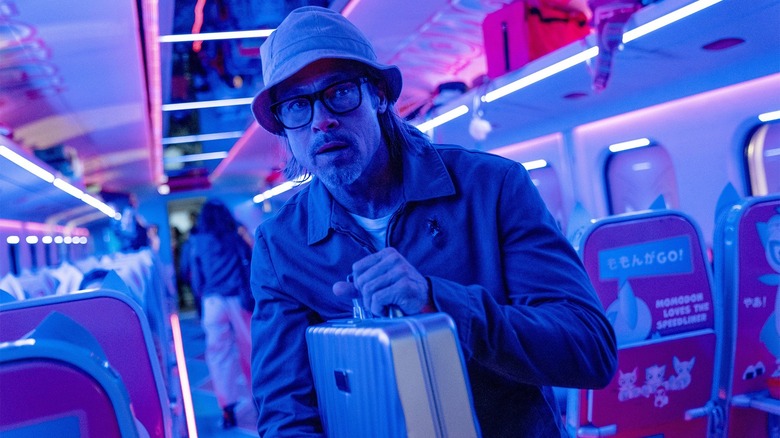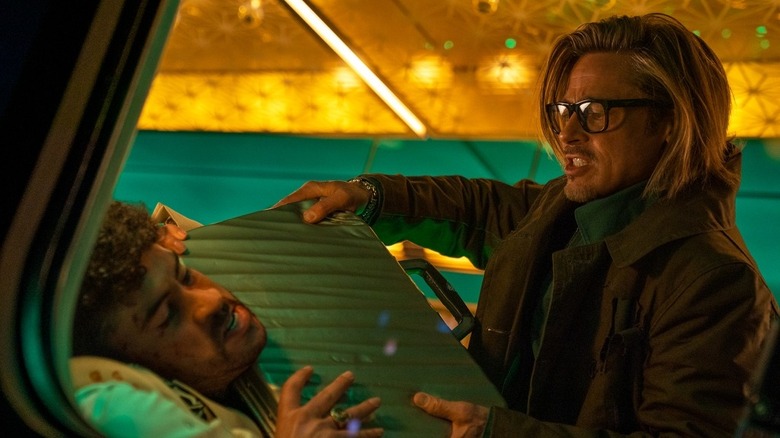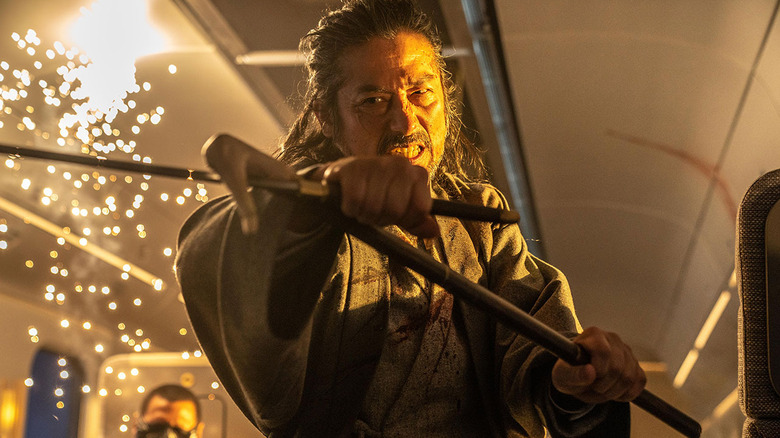Bullet Train Director David Leitch And Producer Kelly McCormick Were 'Full-On Mining From Jackie Chan's Playbook' [Interview]
David Leitch has spent years and years studying Jackie Chan's work. "When it comes to fight scenes, there's no one better in the history of fights than Jackie Chan," Leitch once told us. "If you really breakdown his style of action, especially his fights, he's very precise. The angle is working specifically for the three moves, and then he cuts. It's not traditional Western cinema where they put five cameras on it and then everybody does the fights and then the editor cuts it up." With Leitch's latest action movie, "Bullet Train," he pays more homage than ever to one of his idols.
For starters, the fights are more comedic than the set pieces in the director's previous movies, including "Atomic Blonde" and "John Wick." There's more slapstick in the Brad Pitt-led ensemble film, in which luck is almost as important as skill. The set pieces are mostly confined to the titular setting, which was a challenge Leith and his producer, 87North co-founder Kelly McCormick, recently told us about during an interview all about action, Jackie Chan, and Pitt's eccentric performance.
'A runaway train -- pun intended -- but in a really good way'
The movie started off a little darker, right? How did the tone get crazier and more comedic along the way?
Leitch: Well, the line for craziness was pretty high, for sure. I think it was infectious. We were making this during the height of the pandemic. We were having so much fun on set and you could feel the energy be lifted with all these crazy moments that were happening in front of our eyes. And so we started to lean into them more and more, and it was really knowing that we could modulate it if we had to, but we were having so much fun and we knew it could translate.
McCormick: I have this theory that because of Covid and the train ... there was the train as the set, and then there were the LED walls, which were like floor to ceiling all the way around the train. To get in and out of the train was so hard that basically the whole crew, which normally is standing around and watching and waiting for their moment and stuff, was really removed from the pod of where the filmmaking was happening. It was almost like, because they were behind closed doors, [the actors] went so gonzo. Nobody was watching, really. It was more ridiculous and bolder and wilder every day, kind of a runaway train — pun intended — but in a really good way.
Ladybug is a weird action hero. Did Brad Pitt always want to strike that tone with his performance?
Leitch: It was early on. We had the conversations of what we wanted to do, tonally — Brad, Kelly, and I. I don't know if the rest of the crew had as detailed conversations as I had with Brad. He was like, "Let's swing for the fences, lean into the comedy, lean into the physical comedy, go for laughs." That's what the world needs right now. That's the tonic of our times. We want to make people laugh and he was bringing it from the beginning, in terms of even his outfit.
McCormick: I think he wanted to come in as an underdog and it was his idea to wear the bucket hat and glasses. Thank God, because we probably wouldn't have been able to get it through. Seriously, you're going to do that to Brad Pitt? The studio even said, "What are you thinking?"
Leitch: The studio was like, "What?"
McCormick: But Brad wanted it. In our opinion, perfect. It was not at all what we had thought of originally when we were like, "Oh my God, we're going to do a Brad Pitt movie." How smart he made that choice, because he can disappear in that and feel more relatable. This character, for me, is so exciting as a protagonist for a commercial film because he's basically a complete pacifist in the middle of an action movie — and an unreliable narrator, let's be honest — but also somebody who doesn't really arc. He's going through his own sh*t to the point where, let's be honest, you can go through all the therapy you want, but in the end, you're kind of the same. You never get to explore that because you always want these sweeping arcs of these characters that go from A to B, and this guy goes back to fart jokes in the end. How lucky. Nobody gets to do that.
David, leaning more into the comedy, especially in the action, did you feel like this is the closest you've gotten to Jackie Chan's approach to action?
Leitch: Yeah, leaning into the comedy aspect of what we were trying to do, make it as fun and irreverent as possible. When you look at Jackie and a lot of those characters that he's had where he is sort of the underdog and he's trying to survive and he's using the props in this fun Buster Keaton-esque way, it was a no-brainer to lean into that and the homage to Jackie's choreography. And so, we were full-on mining from Jackie's playbook, for sure.
McCormick: Just the notion that he is a pacifist in the middle of action who does the most damage of anyone on the train is just like a playground for you to be able to play in all the fun ways. I mean, I think Brad got so obsessed with Jackie that he's like, "There's not enough documentaries about the guy." He became a huge fan, for sure. Maybe he was already.
Leitch: Yeah, I think he was, but he leaned into it and we got more and more into him through this process.
'There was that era in the '80s that was the pinnacle of stunts'
The stunts back in Jackie Chan's prime were, really, the wild, wild west. Even going back 25 years, David, how do you think stunt performing has changed and evolved to today?
Leitch: It's changed dramatically. With visual effects getting more and more sophisticated, you can do a lot more things safely than you could before. I think there was that era in the '80s that was the pinnacle of stunts, the Hal Needham days, and then Jackie in the '80s as well and his Hong Kong movies. And then into the '90s, the things that he was doing for real, without safety wires and without enhancements were pretty daunting and special. That was the beginning of my career. I think we were there sort of at the stage of the advent of using a lot of wires for safety, and obviously, the "Matrix" movies where visual effects were hugely important. And it's really evolved, and for the better, I think. We can still do crazy, provocative scenes, but we can put people in the action safer and we can put stunt people in the action safer.
How was it planning all the stunts and the action, obviously, in such a contained space?
McCormick: I think that was one of David's biggest concerns about entering the film at all was, "How do I entertain these people, the audience? When we're stuck on a train for two hours, what is the action really going to be able to be because of the confines of the set?" By the way, we shot everything on a stage because of Covid, so we couldn't go anywhere. Sony actually had availability because the TV shows had shutdown. There were all these stages available on the Sony lot. They hadn't shot a movie there since "Mr. & Mrs. Smith."
We took over two-and-a-half stages and we had very few actual cars that the poor set decorating department had to keep changing out, because there are 13 cars on our train. A lot of times it's only a piece of another car or it's the same car that's been changed. Like the numbers changed, a screen has changed here and there overnight, and you're now on that train. Then there was one first class car and then the conductor car where the Aaron Taylor-Johnson and Brad fight happens, which served as the front and the back of the car. The lounge car was a separate piece, and we only had one platform. So each of those platforms were converting into a wholly different platform when we needed to shoot it again.
So the scheduling of that, plus all of the cameos that came in and out was an absolute nightmare. We wouldn't have been able to do it without such an amazing production staff — especially with our AD Paul Berry, who's the best in the world.
With regards to the stunts, the cars don't really have flyaway walls. They are only about 10% bigger than a normal Shinkansen train. The way in which they shot it required all of that in mind, which I think makes for a really exciting and innovative fight, because of the camera work that is required for that tiny space as well.
Leitch: I really wanted to lean into those flashback sequences where we got to escape the train. So you have all the stakes you're building up. They've got to find the case. And then we boom out for a good four-minute sequence of the Wolf (Michael Shannon) telling his story. Now you're in Mexico. There's a kid. You're giving the audience a chance to have a breath. You're learning about a character in depth, and then you pop right back on the train ... normally, the instinct is to make those flashbacks really short, but my instincts were, "No, let's make them escapes from this confined space and give some scope to the movie and then bring us back." So it was fun. It was a fun device.
For you both, what makes certain actors so adept and skilled at action? What common traits do these actors, like Brad Pitt or Charlize Theron, share?
McCormick: I think the team also sets them up to win, with regards to both great, great training, but also finding the things that they naturally do well and creating the action around those tools for the specific character. It allows for them to get up to speed really quickly, because they're grabbing onto the things that they do naturally really well.
Leitch: Usually, it's work ethic. And also, performance is performance. When someone is really good at acting and accessing that talent that they have, they can physically manifest it, not only with their voice or with their face, but they can physically manifest it. To be able to mimic motion or to copy motion is generally in the wheelhouse of good actors. And the discipline of wanting to deliver the character on all levels. They usually come in and work their a**es off.
"Bullet Train" opens in theaters August 5, 2022.


